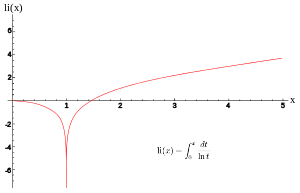Logarithmic integral function
In mathematics, the logarithmic integral function or integral logarithm li(x) is a special function. It is relevant in problems of physics and has number theoretic significance, occurring in the prime number theorem as an estimate of the number of prime numbers less than a given value.

Integral representation
The logarithmic integral has an integral representation defined for all positive real numbers x ≠ 1 by the definite integral
Here, ln denotes the natural logarithm. The function 1/ln(t) has a singularity at t = 1, and the integral for x > 1 has to be interpreted as a Cauchy principal value,
Offset logarithmic integral
The offset logarithmic integral or Eulerian logarithmic integral is defined as
or, integrally represented
As such, the integral representation has the advantage of avoiding the singularity in the domain of integration.
This function is a very good approximation to the number of prime numbers less than x.
Series representation
The function li(x) is related to the exponential integral Ei(x) via the equation
which is valid for x > 0. This identity provides a series representation of li(x) as
where γ ≈ 0.57721 56649 01532 ... ![]() A001620 is the Euler–Mascheroni gamma constant. A more rapidly convergent series due to Ramanujan [1] is
A001620 is the Euler–Mascheroni gamma constant. A more rapidly convergent series due to Ramanujan [1] is
Special values
The function li(x) has a single positive zero; it occurs at x ≈ 1.45136 92348 ... ![]() A070769; this number is known as the Ramanujan–Soldner constant.
A070769; this number is known as the Ramanujan–Soldner constant.
li(2) ≈ 1.045163 780117 492784 844588 889194 613136 522615 578151… ![]() A069284
A069284
This is where is the incomplete gamma function. It must be understood as the Cauchy principal value of the function.
Asymptotic expansion
The asymptotic behavior for x → ∞ is
where is the big O notation. The full asymptotic expansion is
or
This gives the following more accurate asymptotic behaviour:
Note that, as an asymptotic expansion, this series is not convergent: it is a reasonable approximation only if the series is truncated at a finite number of terms, and only large values of x are employed. This expansion follows directly from the asymptotic expansion for the exponential integral.
Number theoretic significance
The logarithmic integral is important in number theory, appearing in estimates of the number of prime numbers less than a given value. For example, the prime number theorem states that:
where denotes the number of primes smaller than or equal to .
See also
References
- Abramowitz, Milton; Stegun, Irene Ann, eds. (1983) [June 1964]. "Chapter 5". Handbook of Mathematical Functions with Formulas, Graphs, and Mathematical Tables. Applied Mathematics Series. 55 (Ninth reprint with additional corrections of tenth original printing with corrections (December 1972); first ed.). Washington D.C., USA; New York, USA: United States Department of Commerce, National Bureau of Standards; Dover Publications. p. 228. ISBN 0-486-61272-4. LCCN 64-60036. MR 0167642. ISBN 978-0-486-61272-0. LCCN 65-12253.
- Temme, N. M. (2010), "Exponential, Logarithmic, Sine, and Cosine Integrals", in Olver, Frank W. J.; Lozier, Daniel M.; Boisvert, Ronald F.; Clark, Charles W., NIST Handbook of Mathematical Functions, Cambridge University Press, ISBN 978-0521192255, MR 2723248